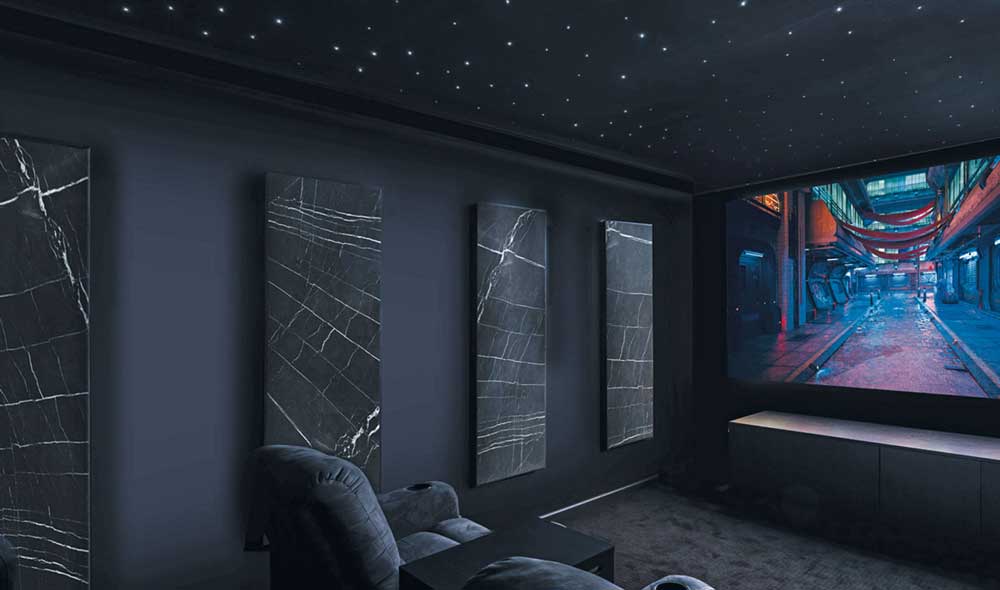
For both home theaters and studios, achieving optimal acoustics is essential for clear, immersive sound. Here are some targeted acoustic solutions to enhance the sound experience in each space:
Sound Absorption
Sound absorption reduces echo, reverb, and excess noise, providing clarity to dialogue in home theaters and accuracy in sound recording for studios.
- Acoustic Panels: Place panels on the walls to absorb mid to high frequencies. In a home theater, this can help focus sound, making dialogue and effects clearer. In studios, this helps avoid unwanted reverb and echoes.
- Bass Traps: Low-frequency sound waves (bass) tend to accumulate in the corners of rooms. Install bass traps in the corners of both home theaters and studios to absorb these low-end frequencies, ensuring tighter bass response.
- Carpets/Rugs: Hard floors can create reflections that muddle sound. Using thick carpets or area rugs will help reduce floor reflections.
Sound Diffusion
Diffusion scatters sound waves evenly, improving the sense of space and preventing dead spots.
- Diffuser Panels: In a home theater, diffusers can be installed behind the listening position to scatter sound reflections, creating a more immersive sound field. For studios, diffusers are particularly useful in live recording rooms where you want to maintain a natural ambiance without excessive reverb.
- Bookshelves/Decor: In home theaters, using bookshelves or textured surfaces can also help diffuse sound without the need for specialized panels.
Soundproofing
For home theaters, soundproofing ensures that sound doesn’t leak into adjacent rooms. In studios, it prevents outside noise from disrupting recordings.
- Mass-Loaded Vinyl (MLV): This dense material is excellent for soundproofing walls, floors, and ceilings. It helps block sound transmission between rooms, making it perfect for both home theaters and studios.
- Acoustic Door Seals: Standard doors are often weak points for sound leakage. Use door seals to prevent sound from escaping.
- Double-Glazed Windows: If your space has windows, double-glazing with air gaps helps insulate against sound entering or leaving the room.
Acoustic Treatment for Ceilings and Floors
For both home theaters and studios, ceiling and floor treatments are important to eliminate unwanted reflections.
- Acoustic Ceiling Tiles: In both environments, especially with high ceilings, acoustic tiles can help absorb sound and reduce reflections.
- Soundproof Underlayments: If your home theater or studio is on an upper floor, use soundproof underlay beneath the flooring to reduce impact noise (like footsteps) and minimize sound traveling between floors.
Speaker Placement and Calibration (Home Theater Specific)
Proper speaker placement is essential for achieving surround sound in a home theater:
- Surround Sound Setup: Position speakers according to the type of surround system (e.g., 5.1, 7.1, or Dolby Atmos). Front speakers should align with the screen, while rear and side speakers should be slightly above ear level.
- Subwoofer Positioning: Place the subwoofer near a wall but away from corners to avoid booming bass that can disrupt the balance of sound. Test various locations to find the optimal spot.
- Room Calibration: Many modern AV receivers offer room calibration features that automatically adjust sound levels to the room’s size and shape.
Floating Floors (Studio Specific)
For recording or mixing studios, floating floors can isolate the studio from external vibrations, such as footsteps or street noise.
- Floating Floor System: This involves creating a floor with layers that "float" on isolators, preventing vibrations from entering or leaving the room.
DIY Acoustic Treatment
If you’re on a budget, you can create some effective DIY solutions:
- DIY Acoustic Panels: You can create your own acoustic panels using rigid fiberglass or foam, wrapped in fabric. These panels can be hung on walls or ceilings.
- Curtains for Sound Absorption: In a home theater, heavy blackout curtains not only block light but also help absorb sound, reducing echo.
Room Design and Layout
The room shape and layout also affect acoustics:
- Avoid Parallel Walls: In studios, square or rectangular rooms with parallel walls can lead to standing waves, which create uneven sound. Installing diffusers or angled surfaces can mitigate this.
- Speaker and Listener Placement: In both home theaters and studios, the “sweet spot” for listening is usually in the middle of the room, with speakers positioned symmetrically to create a balanced sound field.
By combining these treatments, you can create a finely tuned environment that offers high-quality sound, whether you're enjoying a movie at home or producing professional-level audio in a studio.

